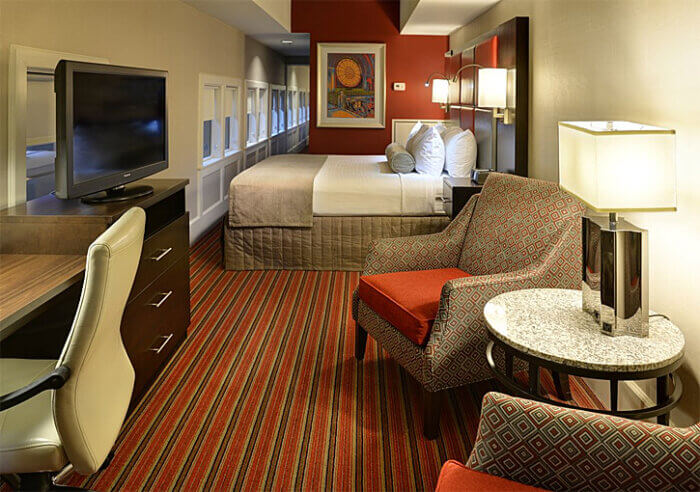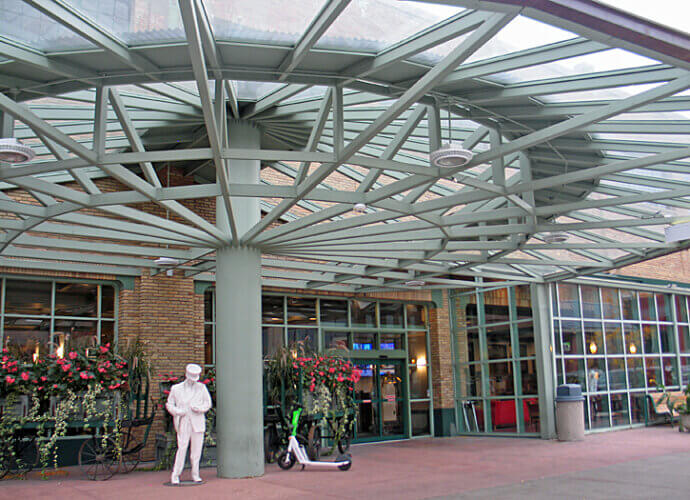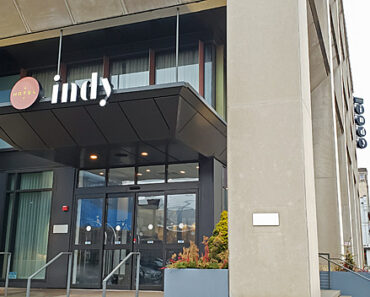A century ago virtually every visitor to Indianapolis arrived by passenger train and alighted at Union Station. Today, the lucky ones now coming by car or plane can spend the night at the Crowne Plaza Hotel Union Station Indianapolis, 123 West Louisiana Street, Indianapolis, Indiana.
The really lucky can sleep in one of the 26 hotel rooms fashioned inside Pullman cars from the 1920s. These classic sleepers were rolled into the train shed and fixed to their tracks before the shed itself was repurposed into the Crowne Plaza Hotel. Some 273 rooms and suites are retrofitted among the original girders. It’s listed on the National Register of Historic Places.
The thoroughly modern hotel has two on-site restaurants, almost fully recovered from their pandemic challenges. At the lobby entrance is 123 West, open daily from 6:30 a.m. to 10 a.m. Taggart’s, open daily from 4 p.m. to 11 p.m. (until 1:30 a.m. on the weekends) offers full dinner service. Because it’s right downtown, there are myriad off-site dining choices — according to Tripadvisor, there are 67 restaurants within a 1/2 kilometer of the hotel.
Guestrooms include complimentary high-speed wireless internet access plus free local calls, a flat-screen television, cable TV, Pay-Per-View channels, a Keurig coffee maker, mini-refrigerator (with two complimentary bottles of water), toiletries, a lighted makeup mirror, and a hair dryer. The hotel has a Fitness Center, Business Center, and an indoor pool.

As a guest of the Crowne Plaza Indianapolis Downtown Union Station, I slept in one of the Pullman train cars. They’re named for historical figures who passed through Union Station — I was in the Rudolph Valentino (others include Charlie Chaplin, Louis Armstrong, John Philip Sousa, Benjamin Harrison, Winston Churchill, Greta Garbo, P.T. Barnum, Cole Porter, Diamond Jim Brady, Amelia Earhart, Lillian Russell, and Jean Harlow). Manufactured in the 1920s, they look as though they’re waiting for transit passengers. Since they’re permanently placed, they’re not going anywhere. However, some of the tracks on the south side of Union Station still are used for trains (almost all of them freight cars).
At check-in, the front desk clerk warned that there “might” be some rumbling from their passing. (Spoiler: I didn’t hear or feel anything.)

My room had a king-sized bed, an uphostered armchair, desk and desk chair. The bathroom was small, with a combination shower/tub — but train cars are narrow, after all. There wasn’t much more than 18 inches between the foot of the bed and the exterior wall of the train car, pierced by many windows looking out into the hotel.
- Search for Great Tours HERE
- Buy Travel Insurance
- Get a Car Rental

The meeting space is extraordinary. The Crowne Plaza Indianapolis Downtown Union Station offers more than 55,000 square feet of event space distributed among 22 rooms for gatherings from intimate to accommodating up to 2,500. The Grand Hall Ballroom — the main room of the historic Union Station, pictured above — provides a unique setting for weddings and other large events.
History of Union Station
For the history buff and train enthusiast, the Crowne Plaza Indianapolis Downtown Union Station offers a transportation tale that dates back almost 175 years. The three-story Union Station is built of granite and brick trimmed with Hummelstown brownstone, with a battered water table, and massive brick arches characteristic of the Romanesque. It features an enormous rose window, slate roof, bartizans at section corners, and a 185-foot clock tower.

As a reminder of that transportation history, guests are greeted by 28 “ghost people” throughout the hotel. There’s a porter at the entrance, passengers from nuns to sailors, and even a trio of teens boosting each other up to ride for free atop a train car.
During its heyday, some 500,000 people used to pass through monthly to catch the 200 trains that steamed through daily. These days, the station is served by Amtrak’s Cardinal line, passing through Indianapolis three times weekly. Most train traffic carries freight.
In 1848, Indianapolis was the first city in the world to come up with the plan for a “union” station that brought train lines owned by various companies into one station. The first building opened on the site in 1853, and was operated by the Indianapolis Union Railway. A much larger Richardsonian Romanesque station was designed by Pittsburgh architect Thomas Rodd. Construction began in 1886, and it opened in 1888. The head house (main waiting area and office) and clock tower of this second station still stand today.
“In the age before automobile and air travel became the norm, Americans traveled by train. Every politician, every movie star, every author, every athlete, every famous (or infamous) person traveling east of the Mississippi traveled through Union Station,” noted Indianpolis author Al Hunter in a 2011 newspaper article about the station.
Travel modes changed drastically after World War II. By 1946, as passenger service fell off, only 64 trains a month operated, and by 1952, barely 50 passenger trains a month used the station.
In 1982, inspired by the success of creative reuse projects in comparatively sized cities like Boston, Baltimore, and San Antonio, the city government stepped in to save the historic landmark. A local development team from Borns Management Corp. was enlisted to renovate the station into a one million-square-foot “urban festival marketplace.”
Robert Borns (corporation principal) and his wife, Sandra, conceived the idea of the “ghost people” to tie the marketplace to its transportation heritage. Made of white fiberglass and steel, they were created by Indianapolis native Gary Rittenhouse, and scattered throughout the mall. Now they reside in the hotel.
Union Station re-opened its doors in 1986 after a $50 million facelift to much fanfare showcasing many specialty shops and fine restaurants. But, then, urban fashion changed again. Facing declining patronage, in 1996 the marketplace was shuttered for yet another renovation. In October 1999, Union Station once again reopened as part of the Crowne Plaza Indianapolis Downtown Union Station, an IHG hotel.
If you stay
Rooms start about $160, but trend upward when there’s a game or event in the nearby Lucas Oil Stadium. You can make a reservation on the hotel’s site or via one of the usual hotel booking sites like Booking.com.
Another hotel romanticizing the Industrial Era in Indianapolis is Ironworks, located on the northeast side of town. Or check out Bottleworks Hotel in an old Coca-cola bottling plant.
The soaring 185-foot clock tower on Union Station is a landmark in downtown Indianapolis.

(Review and some photographs by Susan McKee; other photos courtesy of the hotel)




